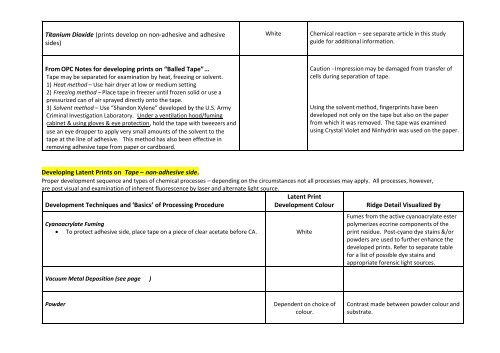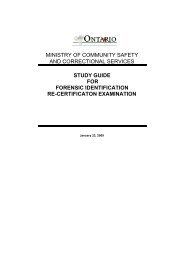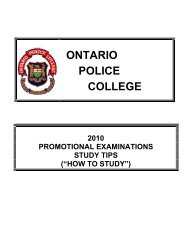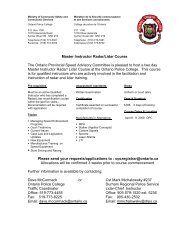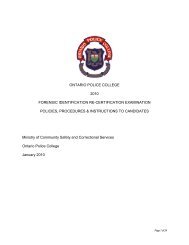General Study Guide - Ontario Police College
General Study Guide - Ontario Police College
General Study Guide - Ontario Police College
You also want an ePaper? Increase the reach of your titles
YUMPU automatically turns print PDFs into web optimized ePapers that Google loves.
Titanium Dioxide (prints develop on non-adhesive and adhesive<br />
sides)<br />
White<br />
Chemical reaction – see separate article in this study<br />
guide for additional information.<br />
From OPC Notes for developing prints on “Balled Tape”…<br />
Tape may be separated for examination by heat, freezing or solvent.<br />
1) Heat method – Use hair dryer at low or medium setting<br />
2) Freezing method – Place tape in freezer until frozen solid or use a<br />
pressurized can of air sprayed directly onto the tape.<br />
3) Solvent method – Use “Shandon Xylene” developed by the U.S. Army<br />
Criminal Investigation Laboratory. Under a ventilation hood/fuming<br />
cabinet & using gloves & eye protection, hold the tape with tweezers and<br />
use an eye dropper to apply very small amounts of the solvent to the<br />
tape at the line of adhesive. This method has also been effective in<br />
removing adhesive tape from paper or cardboard.<br />
Caution - Impression may be damaged from transfer of<br />
cells during separation of tape.<br />
Using the solvent method, fingerprints have been<br />
developed not only on the tape but also on the paper<br />
from which it was removed. The tape was examined<br />
using Crystal Violet and Ninhydrin was used on the paper.<br />
Developing Latent Prints on Tape – non-adhesive side.<br />
Proper development sequence and types of chemical processes – depending on the circumstances not all processes may apply. All processes, however,<br />
are post visual and examination of inherent fluorescence by laser and alternate light source.<br />
Latent Print<br />
Development Techniques and ‘Basics’ of Processing Procedure<br />
Development Colour<br />
Ridge Detail Visualized By<br />
Cyanoacrylate Fuming<br />
To protect adhesive side, place tape on a piece of clear acetate before CA.<br />
Vacuum Metal Deposition (see page )<br />
White<br />
Fumes from the active cyanoacrylate ester<br />
polymerizes eccrine components of the<br />
print residue. Post-cyano dye stains &/or<br />
powders are used to further enhance the<br />
developed prints. Refer to separate table<br />
for a list of possible dye stains and<br />
appropriate forensic light sources.<br />
Powder<br />
Dependent on choice of<br />
colour.<br />
Contrast made between powder colour and<br />
substrate.


